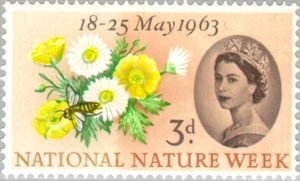Stamp: Buttercup, Common Daisy, Honey Bee (Apis sp.) - Phosphor (United Kingdom of Great Britain & Northern Ireland 1963)
Buttercup, Common Daisy, Honey Bee (Apis sp.) - Phosphor (United Kingdom of Great Britain & Northern Ireland 1963)
16 May (United Kingdom of Great Britain & Northern Ireland ) within release National Nature Week goes into circulation Stamp Buttercup, Common Daisy, Honey Bee (Apis sp.) - Phosphor face value 3 British penny
| Stamp Buttercup, Common Daisy, Honey Bee (Apis sp.) - Phosphor in catalogues | |
|---|---|
| Michel: | Mi:GB 357y |
| Yvert et Tellier: | Yt:GB 373A |
| Stanley Gibbons: | Sg:GB 637p |
| AFA number: | AFA:GB 351D |
Stamp is horizontal format.
Three phosphor bandsAlso in the issue National Nature Week:
- Stamp - Buttercup, Common Daisy, Honey Bee (Apis sp.) face value 3;
- Stamp - Buttercup, Common Daisy, Honey Bee (Apis sp.) - Phosphor face value 3;
- Stamp - European Badger (Meles meles), Roe Deer (Capreolus capreolus face value 4½;
- Stamp - European Badger (Meles meles), Roe Deer (Capreolus capreolus face value 4½;
- Stamp - Buttercup, Common Daisy, Honey Bee (Apis sp.) - Phosphor face value 3;
Stamp Buttercup, Common Daisy, Honey Bee (Apis sp.) - Phosphor it reflects the thematic directions:
Special Occasions
A flower, sometimes known as a bloom or blossom, is the reproductive structure found in plants that are floral (plants of the division Magnoliophyta, also called angiosperms). The biological function of a flower is to effect reproduction, usually by providing a mechanism for the union of sperm with eggs. Flowers may facilitate outcrossing (fusion of sperm and eggs from different individuals in a population) or allow selfing (fusion of sperm and egg from the same flower). Some flowers produce diaspores without fertilization (parthenocarpy). Flowers contain sporangia and are the site where gametophytes develop. Many flowers have evolved to be attractive to animals, so as to cause them to be vectors for the transfer of pollen. After fertilization, the ovary of the flower develops into fruit containing seeds. In addition to facilitating the reproduction of flowering plants, flowers have long been admired and used by humans to beautify their environment, and also as objects of romance, ritual, religion, medicine and as a source of food.
Environmental protection is the practice of protecting the natural environment by individuals, groups and governments.Its objectives are to conserve natural resources and the existing natural environment and, where it is possible, to repair damage and reverse trends.
Flora is the plant life occurring in a particular region or time, generally the naturally occurring or indigenous—native plant life. The corresponding term for animal life is fauna. Flora, fauna and other forms of life such as fungi are collectively referred to as biota. Sometimes bacteria and fungi are also referred to as flora, as in the terms gut flora or skin flora.




